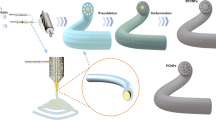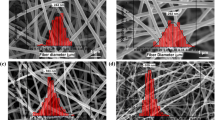Abstract
This study focuses on the systematic development of free-standing mats consisting of nonwoven carbon nanofibers (CNFs) via electrospinning for a lithium–oxygen battery (LOB) cathode. Electrospun fiber mats prepared using a polyacrylonitrile polymer were carbonized to CNFs at various temperatures ranging from 800 to 1200 °C. The diameter of the CNFs was controlled from 500 to 100 nm. The graphitization degree of the CNFs increased with increasing carbonization temperatures and decreasing CNF diameters and, thus, generated a higher electrical conductivity. The electrochemical performance of CNF cathodes with the different physicochemical properties was systematically evaluated together with close observation of discharge products and gas analyses. The LOB cell using the CNF-100–1200 cathode, with the smallest diameter and highest graphitization degree, exhibited the interesting galvanostatic performance with specific capacity of 7832 mAh/g at 200 mA/g and a cycle stability of 173 cycles with a cut-off capacity of 1000 mAh/g at 500 mA/g among the samples.
Graphical abstract










Similar content being viewed by others
Data availability
The data that support the findings of this study are available within the article. There are no data that need to be stored and presented.
References
W.H. Ryu, T.H. Yoon, S.H. Song, S. Jeon, Y.J. Park, I.D. Kim, Bifunctional composite catalysts using Co3O4 nanofibers immobilized on nonoxidized graphene nanoflakes for high-capacity and long-cycle Li–O2 batteries. Nano Lett. 13, 4190–4197 (2013). https://doi.org/10.1021/nl401868q
F. Duffner, M. Wentker, M. Greenwood, J. Leker, Battery cost modeling: a review and directions for future research. Renew. Sustain. Energy Rev. 127, 109872 (2020). https://doi.org/10.1016/j.rser.2020.109872
H.-G. Jung, J. Hassoun, J.-B. Park, Y.-K. Sun, B. Scrosati, An improved high-performance lithium–air battery. Nat. Chem. 4, 579–585 (2012). https://doi.org/10.1038/nchem.1376
Z. Qian, R. Guo, Y. Ma, C. Li, L. Du, Y. Wang, C. Du, H. Huo, G. Yin, Se-doped carbon as highly stable cathode material for high energy nonaqueous Li–O2 batteries. Chem. Eng. Sci. 214, 115413 (2020). https://doi.org/10.1016/j.ces.2019.115413
A.C. Luntz, B.D. McCloskey, Nonaqueous Li–air batteries: a status report. Chem. Rev. 114, 11721–11750 (2014). https://doi.org/10.1021/cr500054y
D.Y. Kim, M. Kim, D.W. Kim, J. Suk, O.O. Park, Y. Kang, Flexible binder-free graphene paper cathodes for high-performance Li–O2 batteries. Carbon 93, 625–635 (2015). https://doi.org/10.1016/j.carbon.2015.05.097
M.W. Ayers, H.-Y.S. Huang, A comprehensive finite element model for lithium–oxygen batteries. J. Mater. Res. 31, 2728–2735 (2016). https://doi.org/10.1557/jmr.2016.306
S.S. Sandhu, G.W. Brutchen, J.P. Fellner, Lithium/air cell: preliminary mathematical formulation and analysis. J. Power. Sources 170, 196–209 (2007). https://doi.org/10.1016/j.jpowsour.2007.04.006
M. Balaish, J.-W. Jung, I.-D. Kim, Y. Ein-Eli, A critical review on functionalization of air-cathodes for nonaqueous Li–O2 batteries. Adv. Func. Mater. 30, 1808303 (2020). https://doi.org/10.1002/adfm.201808303
H.-D. Lim, Y.S. Yun, S.Y. Cho, K.-Y. Park, M.Y. Song, H.-J. Jin, K. Kang, All-carbon-based cathode for a true high-energy-density Li–O2 battery. Carbon 114, 311–316 (2017). https://doi.org/10.1016/j.carbon.2016.12.014
M. Lee, Y. Yoo, J.H. Kwak, Y.S. Yun, H.-G. Jung, D. Byun, S.H. Oh, H.-D. Lim, Effect of surface characteristics of carbon host on electrochemical performance of nonaqueous Li–O2 batteries. Chem. Eng. J. 412, 128549 (2021). https://doi.org/10.1016/j.cej.2021.128549
E. Nasybulin, W. Xu, M.H. Engelhard, Z. Nie, X.S. Li, J.-G. Zhang, Stability of polymer binders in Li–O2 batteries. J. Power. Sources 243, 899–907 (2013). https://doi.org/10.1016/j.jpowsour.2013.06.097
S.S. Zhang, T.R. Jow, Study of poly(acrylonitrile-methyl methacrylate) as binder for graphite anode and LiMn2O4 cathode of Li-ion batteries. J. Power. Sources 109, 422–426 (2002). https://doi.org/10.1016/S0378-7753(02)00107-6
Q.-C. Zhu, F.-H. Du, S.-M. Xu, Z.-K. Wang, K.-X. Wang, J.-S. Chen, Hydroquinone resin induced carbon nanotubes on Ni foam as binder-free cathode for Li–O2 batteries. ACS Appl. Mater. Interfaces 8, 3868–3873 (2016). https://doi.org/10.1021/acsami.5b10669
H.T. Bui, D.Y. Kim, D.W. Kim, J. Suk, Y. Kang, Carbon nanofiber@platinum by a coaxial electrospinning and their improved electrochemical performance as a Li−O2 battery cathode. Carbon 130, 94–104 (2018). https://doi.org/10.1016/j.carbon.2017.12.111
H.T. Bui, D.Y. Kim, Y.Y. Kim, N.H. Le, D.W. Kim, J. Suk, Y. Kang, Macroporous carbon nanofiber decorated with platinum nanorods as free-standing cathodes for high-performance Li–O2 batteries. Carbon 154, 448–456 (2019). https://doi.org/10.1016/j.carbon.2019.08.025
A.L. Andrady, Science and technology of polymer nanofibers (John Wiley, New Jersey, 2007)
Y. Yang, A. Centrone, L. Chen, F. Simeon, T. Alan Hatton, G.C. Rutledge, Highly porous electrospun polyvinylidene fluoride (PVDF)-based carbon fiber. Carbon 49, 3395–3403 (2011). https://doi.org/10.1016/j.carbon.2011.04.015
S. Radhakanth, R. Singhal, In–situ synthesis of MnO dispersed carbon nanofibers as binder-free electrodes for high-performance supercapacitors. Chem. Eng. Sci. 265, 118224 (2023). https://doi.org/10.1016/j.ces.2022.118224
Y. Liu, J. Zhou, L. Chen, P. Zhang, W. Fu, H. Zhao, Y. Ma, X. Pan, Z. Zhang, W. Han, E. Xie, Highly flexible freestanding porous carbon nanofibers for electrodes materials of high-performance all-carbon supercapacitors. ACS Appl. Mater. Interfaces 7, 23515–23520 (2015). https://doi.org/10.1021/acsami.5b06107
J. Huang, B. Zhang, Y.Y. Xie, W.W.K. Lye, Z.-L. Xu, S. Abouali, M. Akbari Garakani, J.-Q. Huang, T.-Y. Zhang, B. Huang, J.-K. Kim, Electrospun graphitic carbon nanofibers with in-situ encapsulated Co–Ni nanoparticles as freestanding electrodes for Li–O2 batteries. Carbon 100, 329–336 (2016). https://doi.org/10.1016/j.carbon.2016.01.012
K.-N. Jung, J.-I. Lee, S. Yoon, S.-H. Yeon, W. Chang, K.-H. Shin, J.-W. Lee, Manganese oxide/carbon composite nanofibers: electrospinning preparation and application as a bi-functional cathode for rechargeable lithium–oxygen batteries. J. Mater. Chem. 22, 21845–21848 (2012). https://doi.org/10.1039/C2JM34500E
H.R. Yao, Y.X. Yin, Y.G. Guo, Size effects in lithium ion batteries. Chin. Phys. B 25, 018203 (2016). https://doi.org/10.1088/1674-1056/25/1/018203
Y. Wu, M.V. Reddy, B.V.R. Chowdari, S. Ramakrishna, Long-term cycling studies on electrospun carbon nanofibers as anode material for lithium ion batteries. ACS Appl. Mater. Interfaces 5, 12175–12184 (2013). https://doi.org/10.1021/am404216j
X.J. Chen, V.V. Bevara, P. Andrei, M. Hendrickson, E.J. Plichta, J.P. Zheng, Combined effects of oxygen diffusion and electronic resistance in li-air batteries with carbon nanofiber cathodes. J. Electrochem. Soc. 161, A1877 (2014). https://doi.org/10.1149/2.0721412jes
A. Cuesta, P. Dhamelincourt, J. Laureyns, A. Martínez-Alonso, J.M.D. Tascón, Comparative performance of X-ray diffraction and Raman microprobe techniques for the study of carbon materials. J. Mater. Chem. 8, 2875–2879 (1998). https://doi.org/10.1039/A805841E
G.A. Zickler, B. Smarsly, N. Gierlinger, H. Peterlik, O. Paris, A reconsideration of the relationship between the crystallite size La of carbons determined by X-ray diffraction and Raman spectroscopy. Carbon 44, 3239–3246 (2006). https://doi.org/10.1016/j.carbon.2006.06.029
F. Tuinstra, J.L. Koenig, Characterization of graphite fiber surfaces with Raman spectroscopy. J. Compos. Mater. 4, 492–499 (1970). https://doi.org/10.1177/002199837000400405
T. Gruber, T.W. Zerda, M. Gerspacher, Raman studies of heat-treated carbon blacks. Carbon 32, 1377–1382 (1994). https://doi.org/10.1016/0008-6223(94)90125-2
S.N. Arshad, M. Naraghi, I. Chasiotis, Strong carbon nanofibers from electrospun polyacrylonitrile. Carbon 49, 1710–1719 (2011). https://doi.org/10.1016/j.carbon.2010.12.056
X. Jiao, Y. Qiu, L. Zhang, X. Zhang, Comparison of the characteristic properties of reduced graphene oxides synthesized from natural graphites with different graphitization degrees. RSC Adv. 7, 52337–52344 (2017). https://doi.org/10.1039/C7RA10809E
Y. Wang, J.J. Santiago-Aviles, Early stages on the graphitization of electrostatically generated PAN nanofibers. Proceedings of the 2nd IEEE conference on nanotechnology. 29–32 (2002)
J.-C. Li, D.-M. Tang, P.-X. Hou, G.-X. Li, M. Cheng, C. Liu, H.-M. Cheng, The effect of carbon support on the oxygen reduction activity and durability of single-atom iron catalysts. MRS Commun. 8, 1158–1166 (2018). https://doi.org/10.1557/mrc.2018.174
M. Naraghi, S.N. Arshad, I. Chasiotis, Molecular orientation and mechanical property size effects in electrospun polyacrylonitrile nanofibers. Polymer 52, 1612–1618 (2011). https://doi.org/10.1016/j.polymer.2011.02.013
S.-C. Wong, A. Baji, S. Leng, Effect of fiber diameter on tensile properties of electrospun poly(ɛ-caprolactone). Polymer 49, 4713–4722 (2008). https://doi.org/10.1016/j.polymer.2008.08.022
D. Papkov, A. Goponenko, O.C. Compton, Z. An, A. Moravsky, X.-Z. Li, S.T. Nguyen, Y.A. Dzenis, Improved graphitic structure of continuous carbon nanofibers via graphene oxide templating. Adv. Funct. Mater. 23, 5763–5770 (2013). https://doi.org/10.1002/adfm.201300653
B.D. McCloskey, A. Valery, A.C. Luntz, S.R. Gowda, G.M. Wallraff, J.M. Garcia, T. Mori, L.E. Krupp, Combining accurate O2 and Li2O2 assays to separate discharge and charge stability limitations in nonaqueous Li–O2 batteries. J. Phys. Chem. Lett. 4, 2989–2993 (2013). https://doi.org/10.1021/jz401659f
M.M. Ottakam Thotiyl, S.A. Freunberger, Z. Peng, P.G. Bruce, The carbon electrode in nonaqueous Li–O2 cells. J. Am. Chem. Soc. 135, 494–500 (2013). https://doi.org/10.1021/ja310258x
S. Nakanishi, F. Mizuno, K. Nobuhara, T. Abe, H. Iba, Influence of the carbon surface on cathode deposits in non-aqueous Li–O2 batteries. Carbon 50, 4794–4803 (2012). https://doi.org/10.1016/j.carbon.2012.06.003
V.S. Bryantsev, F. Faglioni, Predicting autoxidation stability of ether- and amide-based electrolyte solvents for Li–air batteries. J. Phys. Chem. A 116, 7128–7138 (2012). https://doi.org/10.1021/jp301537w
A. Khetan, H. Pitsch, V. Viswanathan, Solvent degradation in nonaqueous Li–O2 batteries: oxidative stability versus H-abstraction. J. Phys. Chem. Lett. 5, 2419–2424 (2014). https://doi.org/10.1021/jz501154v
W. Walker, V. Giordani, J. Uddin, V.S. Bryantsev, G.V. Chase, D. Addison, A rechargeable Li–O2 battery using a lithium nitrate/N,N-Dimethylacetamide electrolyte. J. Am. Chem. Soc. 135, 2076–2079 (2013). https://doi.org/10.1021/ja311518s
B. Liu, W. Xu, P. Yan, P. Bhattacharya, R. Cao, M.E. Bowden, M.H. Engelhard, C.-M. Wang, J.-G. Zhang, In Situ-grown ZnCo2O4 on single-walled carbon nanotubes as air electrode materials for rechargeable lithium-oxygen batteries. Chemsuschem 8, 3697–3703 (2015). https://doi.org/10.1002/cssc.201500636
J. Xie, X. Yao, Q. Cheng, I.P. Madden, P. Dornath, C.-C. Chang, W. Fan, D. Wang, Three dimensionally ordered mesoporous carbon as a stable, high-performance Li–O2 battery cathode. Angew. Chem. Int. Ed. 54, 4299–4303 (2015). https://doi.org/10.1002/anie.201410786
S.M. Cho, S.W. Hwang, J.H. Yom, W.Y. Yoon, Pd3Co/MWCNTs composite electro-catalyst cathode material for use in lithium-oxygen batteries. J. Electrochem. Soc. 162, A2236 (2015). https://doi.org/10.1149/2.0321512jes
B. Sun, X. Huang, S. Chen, P. Munroe, G. Wang, Porous graphene nanoarchitectures: an efficient catalyst for low charge-overpotential, long life, and high capacity lithium-oxygen batteries. Nano Lett. 14, 3145–3152 (2014). https://doi.org/10.1021/nl500397y
K. Song, J. Jung, M. Park, H. Park, H.-J. Kim, S.-I. Choi, J. Yang, K. Kang, Y.-K. Han, Y.-M. Kang, Anisotropic surface modulation of Pt catalysts for highly reversible Li–O2 batteries: high index facet as a critical descriptor. ACS Catal. 8, 9006–9015 (2018). https://doi.org/10.1021/acscatal.8b02172
J.-J. Xu, Z.-L. Wang, D. Xu, L.-L. Zhang, X.-B. Zhang, Tailoring deposition and morphology of discharge products towards high-rate and long-life lithium-oxygen batteries. Nat. Commun. 4, 2438 (2013). https://doi.org/10.1038/ncomms3438
Acknowledgments
This study was supported by the Korea Research Institute of Chemical Technology. This research was funded by Vietnam National Foundation for Science and Technology Development (NAFOSTED) under grant number 103.99-2020.67.
Funding
This work was funded by National Foundation for Science and Technology Development, 103.99-2020.67, Hieu Trung Bui. This work was also supported by the Korea Research Institute of Chemical Technology.
Author information
Authors and Affiliations
Contributions
HTB contributed to conceptualization, data curation, methodology, investigation, and writing-original draft. TYK contributed to investigation. DYK contributed to investigation, writing-original draft, writing-review & editing, and supervision. DWK contributed to investigation, data curation, and validation. JS contributed to validation. YK contributed to supervision, project administration, and funding acquisition.
Corresponding authors
Ethics declarations
Conflict of interest
The authors declare that they have no known competing financial interests or personal relationships that could have appeared to influence the work reported in this paper.
Additional information
Publisher's Note
Springer Nature remains neutral with regard to jurisdictional claims in published maps and institutional affiliations.
Supplementary Information
Below is the link to the electronic supplementary material.
Rights and permissions
Springer Nature or its licensor (e.g. a society or other partner) holds exclusive rights to this article under a publishing agreement with the author(s) or other rightsholder(s); author self-archiving of the accepted manuscript version of this article is solely governed by the terms of such publishing agreement and applicable law.
About this article
Cite this article
Bui, H.T., Kim, T.Y., Kim, D.Y. et al. Effects of different fabrication conditions on the performance of free-standing carbon nanofiber cathodes in lithium–oxygen batteries. Journal of Materials Research 39, 535–547 (2024). https://doi.org/10.1557/s43578-023-01248-7
Received:
Accepted:
Published:
Issue Date:
DOI: https://doi.org/10.1557/s43578-023-01248-7




